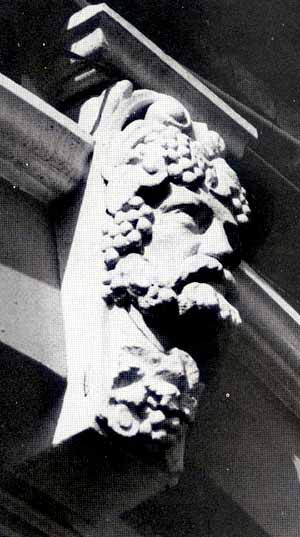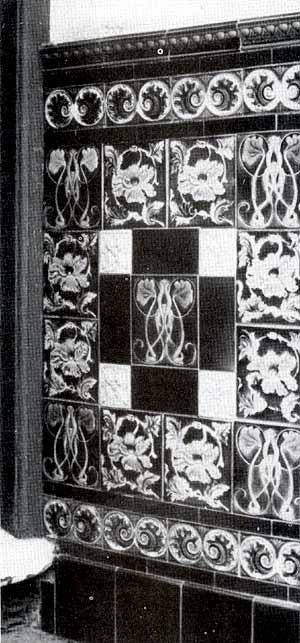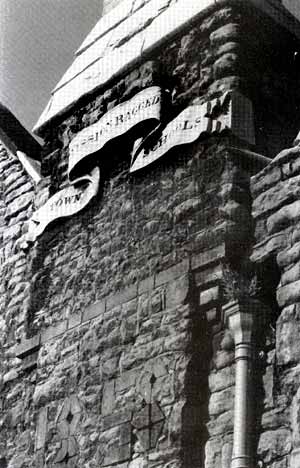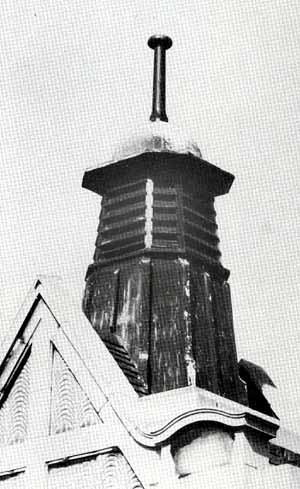< Previous
MORE THAN MEETS THE EYE :
The Sneinton nobody notices
By Stephen Best
 A STONE HEAD at the side of the Peggers Inn.
A STONE HEAD at the side of the Peggers Inn.It may seen fanciful to suggest that Sherlock Holmes has something to teach us about enjoying the minor pleasures of Sneinton, yet a walk through its streets can be greatly enhanced if we bear in mind what he said in 'A Case of Identity'. Addressing a bewildered client, he remarked 'Perhaps I have trained myself to see what others overlook', adding that 'It has long been an axiom of mine that the little things are infinitely the most important'.
Taking to heart this injunction to keep one's eyes open and to ignore nothing, the casual observer can find plenty to look at in what may appear to be quite unpromising surroundings. Private houses, public buildings and commercial premises alike may possess some feature which, if not worth going miles to see, is nevertheless worthy of notice and enjoyment as we pass, and adds to the character of the neighbourhood.
Like many other inner-city areas, Sneinton may, on superficial acquaintance seem grey and colourless. Colourless, though, it most certainly is not, as may be judged from a glance at the glazed ceramic tiles in the front porches of many of its houses. More than thirty Sneinton streets possess examples of these tiles, almost invariably in houses built between the turn of the century and the outbreak of the Great War. The variety of colours, styles and combinations of tiles is astonishing, and over 200 different examples have been photographed by me. They range from the rather plain and subdued designs to be found in, say, Pullman Road, through the enjoyable variety of tiles on view in streets such as Sedgley Avenue, Sneinton Boulevard and Sneinton Hermitage, to some truly wonderful displays of colour and pattern in a few fortunate locations. The walker with only a few minutes to spare would perhaps do best to look at the tiles in Loughborough Avenue, Holborn Avenue and Port Arthur Road.
 COLOURFUL EDWARDIAN TILES adorn a porch in Holborn Avenue.
COLOURFUL EDWARDIAN TILES adorn a porch in Holborn Avenue.Loughborough Avenue can show blackberries, water-lilies and some striking Art Nouveau flowers which resemble panels of stained glass. The Holborn Avenue tiles include some very richly coloured naturalistic and stylised flowers, some of the latter looking like Aubrey Beardsley creations. One particularly original design incorporates a flowery stem in a geometric T-shape. Port Arthur Road has striking stylised flowers in gorgeous colours; blues, yellows, greens, browns and oranges. Here, as in tiles elsewhere in Sneinton, the flower designs sometimes take on the appearance of fantastic insect forms. The tiles usually form a dado only in the porches, but the observant Sneinton watcher will spot houses in Sneinton Dale, Ashfield Road, Ladysmith Street and Colwick Road whose porches are tiled to their full height. While the variety of tile designs in Sneinton is, as already suggested, astonishing, it is equally amazing that some householders lucky enough to possess these delightful decorations value them so lightly as to paint over them or, worse still, fix meter boxes over them or hack them off altogether. House builders in Sneinton seem to have restricted the use of external ceramic tiles to front porches, but a happy exception can be found on the house at the corner of Manor Street and Lees Hill Street. Here, on the bays beneath the bedroom windows are pretty tiles depicting apples: good enough to eat they look.
Sneinton's front doorways have more to offer though, than just their tiles. Many houses exhibit carved heads at the ends of the stone hood-moulds above their doorways. These frequently take the form of fiercely moustached males with a hint of Anglo-Saxon chieftain about them, paired uneasily with vapid females of the sort once depicted in children’s book illustrations as chained to rocks, awaiting rescue from monsters. In a few instances houseproud residents have painted these heads, conferring bright colours upon lips, moustaches, eyeballs and hair; the resultant effect is, though arresting, indescribably absurd. St. Stephen's Road has a fine selection of stone heads, and there are some very good ones on two houses at the bottom of Sneinton Hollows. Some houses sport, instead of heads, carved flowers. They are agreeable enough, without having quite the character of the heads. Carved decoration to windows is, in comparison, more sparingly applied. One spirited example is a group of houses at the Colwick Road end of Baden Powell Road. Most of this terrace happily retains the original stone mullions dividing the windows, and the mullions possess capitals on which heads peer out from leafy surrounds. The heads include boys and girls, together with moustached and bearded men. The foliage around the heads, too, is enjoyably varied from house to house. While in Baden Powell Road, the explorer may care to take a look at the first house below Sneinton Boulevard, with curious triangular pedimented heads to door and window, rather out-of-scale and quite unlike any other house in the vicinity. Fussy decoration abounds, and the building looks rather as though the builder had determined on showing off all the effects in his pattern book.
On Trent Lane, opposite the 'Earl Manvers' pub, is a row of houses, unremarkable except for its end wall, which accommodates a rapidly fading relic of Sneinton's past. This is a large advertisement, painted direct on to the brickwork, for the Riverside Pleasure Park. Older readers will have a clear recollection of the delights offered here, and I can just remember wartime visits made when I was little more than a toddler. On the advert, the words 'Seaside at home: music, singing and dancing' can be made out, with an idyllic painted background of a Trent-side grove of trees. My memories, it must be confessed, are of less sophisticated attractions; swings, sandpit and paddling pool. Of all the Sneinton treasures mentioned in this short but rambling article, this is, one suspects, the most fragile, and the advertisement should be enjoyed before it fades away for ever. If, prompted by a wave of nostalgia, one walks down Trent Lane to the river, it is still possible to see vestiges of the Pleasure Park among the bustle of a present-day marina and chandlery.
Trent Lane is terminated most emphatically by a sturdy brick wall built across its end at the river's edge. Set into this wall is an inconspicuous and overlooked feature of Sneinton. This is a large stone, inscribed thus: 'Beck Valley Storm Water Culvert. In the Mayoralty of Mr. Alderman Manning J.P., this stone was laid by Mr. Alderman Turney J.P., Chairman of the General Works and Highways Committee, on the 7th day of August 1884....'. The Beck rises at St. Ann’s Well, and used to form part of the old boundary between Sneinton and Nottingham. For well over a century it has been culverted, and it now flows under St. Ann’s Well Road, Beck Street, and the Manvers Street bus garages before emerging modestly, in its role as part of the City’s drainage system, into the Trent at Sneinton.
From this reminder of Victorian civic enterprise, we move on to a building so familiar that few of us ever stop to look at it. This is Sneinton Library, opened in 1928 with a good deal of local publicity, including a news-sheet distributed to houses in the locality. Designed by the City Engineer, T. Wallis Gordon, who was also responsible for the War Memorial Arch on the Embankment, the building is in a fairly nondescript municipal style. It possesses, though, two very crisply carved stone plaques between the upper windows, both of them framed by trails of fruits. One plaque bears the date of building, the other the three crowns and ragged cross of the Nottingham arms. This latter carving has reminded at least one fanciful onlooker of a person in a long wig, smoking a cigarette. (Go and look for yourself.) The same Borough arms can be found on the old Sneinton Hermitage police station. Beneath the carved shield is the year of construction 1894, and just in case any casual passer-by might be unsure of the building’s original purpose, the word 'Police' is boldly carved over the entrance.
One local building of undeniable usefulness but little beauty is the City Transport bus garage which sprawls between Lower Parliament Street an Manvers Street. The building bears, though, a surprising number of minor embellishments, some of which are quite enjoyable. At the corner of Stanhope Street (and best viewed from the Ice Stadium car park) is an attractively decorated stone panel reading. 'Nottingham Corporation Tramways 1926'. The same date appears on a carved stone (very like the Sneinton Library carvings) on the Southwell Road frontage, which is further rigged out with carved swags, draperies and wreaths. By the time that the depot's Manvers Street elevation was completed, a further year had elapsed, so we find the date 1927 at this corner, flanking a now-blocked circular clockface. Parliament Street garage is thus one of the few Nottingham buildings to bear two different dates upon it.
Across the road stands the former Fox and Grapes pub, now renamed the Peggers Inn, and characterised by some startingly colourful and inventive announcements painted on its windows. On each side of the building, tucked away down avenues of the Wholesale Market and consequently not much noticed, are three keystones above the ground floor windows. These take the form of human heads, three bearded and three clean-shaven, adorned with grapes, hops and, one assumes, other fruits used in the making of drink. A different, and easily identifiable, fruit can be found on Fyffe's warehouse at the corner of Brook Street and Gedling Street. This is a quite remarkable essay in moulded bricks in the form of a bunch of bananas. It is one of Nottingham's happiest architectural decorations.
 THE FORMER TOWN MISSION RAGGED SCHOOL’S NAME appears above the date-bricks, 1858.
THE FORMER TOWN MISSION RAGGED SCHOOL’S NAME appears above the date-bricks, 1858.This area around Sneinton Market has a number of buildings with some detail worth looking out for. Easily the most decrepit is the former Town Mission Ragged Schools, whose condition has caused concern for some years. Despite the '1858' crudely fashioned in red and blue bricks on the Gedling Street frontage, the schools, whose name is delightfully carved on a stone ribbon, were opened on October 19th 1859 by Lord Shaftesbury, for forty years President of the Ragged School Union. The opening day arrangements were thrown into disarray by the late running of His Lordship's train. One cannot help feeling, on looking at the building, that the carver responsible for the delicate name ribbon would have felt nothing but contempt for the botcher who perpetrated the brick '1858'. The schools were opened by the Town Mission 'for the purpose of aiding in the removal of that ignorance, destitution, and vice, so prevalent among the juvenile population; by imparting a scriptural and useful education to those little ones, and by training them in habits of industry and honesty'. They were taken over by the Nottingham School Board in 1878.
Next door to the Ragged School, the Victoria Baths building of 1896 contributes to the local skyline the familiar 'Bath Clock'. The most quirky features of the clock tower are the minuscule stone balconies on its faces. One imagines that these were used to accommodate the ladder of the man who cleaned the clock faces. Over the entrances can be found the Nottingham arms, while, further up Bath Street, another nineteenth century building possesses a frequently overlooked feature of interest. We have now arrived at what used to be Bath Street Schools, the first Board School built in Nottingham: it is now the Bath Street Centre. A peep through the railings at the end nearest to St. Ann's Well Road, or a discreet trespass if the gate is open, will reveal above the door a carved memorial stone recording that it was laid in 1873 by the Rev. Francis Morse, Vicar of St. Mary’s from 1864 to 1886. This stone, too, bears the crowns and ragged cross of the Nottingham arms. The carved ribbon with the words: 'Faith? Virtue: Knowledge' is very nicely done, but the spacing of the rest of the wording suggests that the carver found the task of fitting the letters neatly into the awkward arch-shaped space almost too much for him.
 THE CITY MISSION, CARLTON ROAD:
A Dalek on the roof ?
THE CITY MISSION, CARLTON ROAD:
A Dalek on the roof ?Across Victoria Park, from Bath Street, the skyline is dominated by the great bulk of Bancroft's factory, with its splendid glazed attic inspection floor. The corner elevation includes two details which are often overlooked. The clock, which passers-by have occasionally dismissed as hopelessly wrong, turns out, on closer investigation, to be a wind direction indicator, and, just below it, is a stone bearing the date 1869 and the initials WW. This records the building of the factory by William Windley, the Nottingham silk throwster who, as a memorial to his father, built All Saints' Church in Raleigh Street. A hundred yards from Bancroft's factory, the Bath Inn merits a glance because of the inventive glazed tiling applied to its exterior. The corner of Bath Street and Handel Street, and the Handel Street doorway surrounds, are especially enjoyable. The triangle of streets bounded by Bath Street, Carlton Road and Handel Street may seem to contain little of interest, but, once again, there are things to see if you look closely. Quite apart from the chubby little dome and carved garlands on the now-closed bank at the corner of Longden Street, and the factory dated 1866 at the other end of that street, there are two buildings of real interest. These lie in Carlton Road, on either side of St. Luke's Street. This name is significant, for the Tennant Rubber Company, with its vaguely Gothic windows and unusual timbered gables, was built in 1864 as the St. Luke’s Parochial School, which closed at the turn of the century. (A richly decorated example of the work of its architect, Frederick Bakewell, remains in Nottingham - the old School of Art in Waverley Street). The final building of this excursion is just across the road, on the site of St. Luke's church. This is the Nottingham City Mission, designed by the local architect Alfred Thraves, and opened in 1927. Its frontage is largely taken up by shop premises and the Carlton Road entrance to the Mission is now blocked up, so it is easy to miss the religious significance of the building. The gable though, has a stone cross set against a background of scallop decoration, while on the roof sits a polygonal lantern. Go and gaze at this lantern, and you will realise that here, over sixty years ago, the Dalek made its first appearance in Nottingham.
This selection of buildings is a purely personal one, and some readers may quite reasonably feel that their particular favourite has been omitted. It is hoped that a further group of buildings in and around Sneinton may be described in a future issue of Sneinton Magazine.
< Previous
